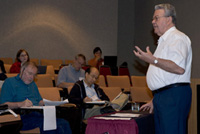 |
|||||||||||
|
|||||||||||
|
|||||||||||
|
CERN DG shares cost-evaluation experience, thoughts on future accelerators
CERN Director General Robert Aymar discussed lessons from his experience in costing the ITER project with members of Global Group 5, Cost and Engineering, at the recent Snowmass ILC Workshop. Aymar led the international team that developed a detailed engineering design for ITER including a cost estimate.
"For ITER, we derived the value, not the cost," Aymar said. The team defined an invented currency, the ITER Unit of Account. They then developed some 100 work packages required to build the project and designed the detailed processes for manufacturing with industries from the international partners, thus determining the amount of materials, labor and other elements for each work package. They then valued all of them in a consistent manner throughout the project, expressed in IUA. ITER partner nations could then get "credit" for their share of in-kind contributions in terms of the IUA for the work packages they undertook. The ITER partner nations could "rebuild" the cost of the work packages in their home currencies. "Two partners contributing in-kind the same component, with the same value in IUA will probably end up with very different costs in their own currencies, compared through exchange rates, because there is no world market for such components," Aymar said. He also advised scientists to keep in mind that government and diplomatic timescales are very different from scientific timescales. "As soon as you get through to the diplomats to get an international agreement, you have to follow their timescale, not the technical timescale," he said. "International cooperation is a good way to slow down everything." In a recent interview, Aymar also discussed aspects of future accelerators. "Whatever the results of LHC might be, a linear collider will be necessary," he said. While many physicists worldwide are working on the ILC design, others are pursuing R&D for the Compact Linear Collider (CLIC), a proposed accelerator scheme using different technology from the ILC. Some scientists work on both the ILC and CLIC. CLIC, whose technical feasibility has not yet been demonstrated, would have a higher energy reach than the ILC. "Although the technologies differ, there are convergence points between them", Aymar said. He explained that nature would decide whether ILC or CLIC should be built.
"There will be two possibilities [ILC or CLIC] for the linear collider depending on what LHC will tell us", Aymar said. In his view, first results from LHC experiments, results of the detailed engineering design for the ILC, and results of feasibility studies on CLIC will make the situation clearer by the end of 2009.
|
|||||||||||
| © International Linear Collider |
